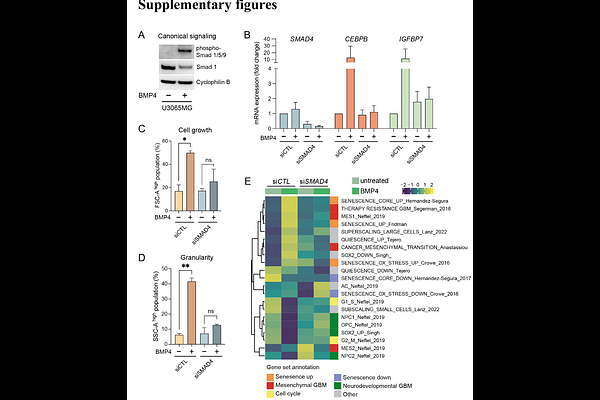BMP4 induces a p21-dependent cell state shift in glioblastoma linking mesenchymal transition to senescence

BMP4 induces a p21-dependent cell state shift in glioblastoma linking mesenchymal transition to senescence
Niklasson, M.; Dalmo, E.; Segerman, A.; Rendo, V.; Westermark, B.
AbstractBone morphogenetic protein 4 (BMP4) has emerged as a potential glioblastoma therapy due to its anti-proliferative effect via SOX2 downregulation and differentiation promotion. However, BMP4 responses vary across and within tumors. Our previous data indicate that BMP4 induces transition to a mesenchymal-like cell state. Mesenchymal transition is associated with therapy-resistance and tumor recurrence, as is senescence in cancer. In this study, we investigated BMP4\'s potential to induce senescence in primary glioblastoma cells, including proneural- and mesenchymal-like clones derived from the same tumor. BMP4 treatment induced senescence-associated genes and phenotypic changes such as cell enlargement, senescence-associated-beta-gal expression, lamin B1 downregulation, and elevated p21 levels. The most robust senescence induction was observed in the mesenchymal-like clone, compared to its proneural counterpart. Notably, mesenchymal-like cells displayed high basal levels of p21 and other senescence-associated markers, suggesting a convergence of mesenchymal and senescent traits. p21 knockout abolished BMP4-induced senescence, maintaining proliferation and cell size despite SOX2 downregulation. Additionally, senolytic treatment effectively eliminated senescent cells through apoptosis, thereby favoring survival of cells retaining normal p21 levels. Our findings demonstrate BMP4\'s ability to induce p21-dependent senescence in glioblastoma, particularly in therapy-resistant mesenchymal-like cells. These insights provide potential therapeutic strategies targeting senescence pathways in this challenging disease.